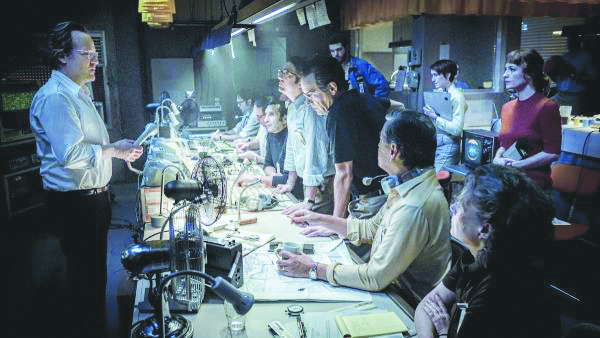The ABC Sports crew covers a terrorist attack at the 1972 Olympics in West Germany in September 5, a swift, tense re-creation of the historical event.
These Olympics are at the dawn of live-via-satellite coverage, we are told, with all the news networks sharing windows on one satellite. Working with a six-hour time difference between Munich and the east coast of the U.S., the ABC sports crew put together packages of sports as well as live sporting events broadcasts. These share screen time with stories from ABC News, such as on-site Peter Jennings (Benjamin Walker) interviewing David Berger (Rony Herman), an American-born Israeli weightlifter, about competing in Germany as the country tries to separate new West Germany from its Nazi past. Then, early, Munich time, in the morning on Sept. 5, the TV crew hears gunfire. They scramble to send out staff and with the help of translator Marianne (Leonie Benesch) they put together that shots were fired in the Olympic Village and that Israeli athletes have been taken hostage. ABC Sports head Roone Arledge (Peter Sarsgaard) demands that the story stay with Sports, and not New York-based ABC News, and works with Geoffrey (John Magaro) to feed as much news and live footage as possible to on-air anchor Jim McKay (shown here in the real-world footage). They build the live coverage capacity as they’re airing it — sending Peter Jennings to a neighboring Olympic Village dorm building to report what he’s seeing in the Israeli rooms and pushing a studio camera out onto the lawn to get live shots of the building and the terrorists who occasionally step onto the balcony. Even the word “terrorists” becomes something of a spur-of-the-moment addition to the coverage, according to the movie — Peter Jennings uses “Palestinian guerillas,” guessing before there’s confirmation that the group Black September may be involved. Roone decides to go with terrorists, which is how the German police refer to the hostage-takers.
As they maneuver cameras and solder telephone wires to get Peter’s reports live on air, the team, in particular Roone, are laser-focused on the “how” of what they’re doing, only slowly realizing that, for example, Olympic village rooms have TVs that receive the ABC broadcast. Thus, they realize, does their ability to offer live coverage outstrip the inexperienced German police’s ability to take that coverage into account with their own plans to attempt to rescue the hostages.
September 5 is a tight retelling of the roughly day-long stand-off mostly focused on how the Sports crew is both watching history and making history for how they are telling the story and how it sets the template for future news coverage. There is no “we’re doing it for the ratings” mustache twirler here, it is just kind of a story of people trying to make the right decisions based on the limited information they have and the sometimes at-odds desires to get the story (and get it first) and not to cause harm. While the movie has solid performances all around, I can see why it is the movie’s no-slack-in-the-rope story that garnered the movie its one Oscar nomination for Best Original Screenplay. B+ Available for rent or purchase.
Nosferatu (R)
A young couple are terrorized, in different ways, by the demonic Count Orlok in Nosferatu, a remake of F.W. Murnau’s 1922 Nosferatu that is full of vibes.
Like, this film looks creepy-beautiful — even the scenes of, say, a coffin full of rats have a kind of grotesque loveliness. This movie reminded me a lot of Maria (which is on Netflix), its nomination-mate in the Best Cinematography category of this year’s Oscars (Nosferatu also got nods for costume design, hair and make up and production design — again, all praise for the look of the thing). Both Nosferatu and Maria (Angelina Jolie’s biopic of Maria Callas) are beautiful to look at and cast a spell that puts you in the art-book-worthy worlds they create. But I fell asleep multiple times during Maria, and Nosferatu crept along in a way that eventually stopped building tension and just had me wishing we’d get to the vampire factory already.
Newly married goofus Thomas Hutter (Nicholas Hoult) travels to Transylvania for a document signing with Count Orlock (Bill Skarsgård, looking like a living corpse) that even in the 19th century feels like it should have been an email. Melancholy-afflicted Ellen Hutter (Lily-Rose Depp), his wife, afraid at home, is wrapped up in foreboding, with moments of mania and what seems like possession. Herr Knock (Simon McBurney), Thomas’s boss, maneuvers for Orlock to, I guess, drain the life out of Thomas so Orlock can come and be with Ellen, who he first seduced years ago somehow. The movie hits all the beats, looks great doing it, but doesn’t push beyond. I feel like, with the plague, the dread of a mysterious plague ship, the inability of science (such as it is) to help Thomas or Ellen, the movie had all kinds of places to dig into something more, to make this story terrifying and relevant. Instead, the “innovation” here seems to be a few boobs shots. C+ Available for rent and in theaters.
Back in Action (PG-13)
Mild-mannered suburban parents are actually former super spies in Back in Action, a one-notch-above-average older-kid family comedy.
Matt (Jamie Foxx) and Emily (Cameron Diaz) were once fighting dudes on airplanes but now they are parents to sassy teen Alice (McKenna Roberts) and computer kid Leo (Rylan Jackson), who both just think their parents are standard-issue uncool Olds. But then Matt and Emily catch 14-year-old Alice and her fake ID at a club and when club muscleheads try to give them some trouble Alice is shocked to watch her parents lay waste to the thick-necked bros. Also shocked is Chuck (Kyle Chandler), Matt and Emily’s old boss who thought they were dead before their “Boomers fighting” video goes viral. If he can find them, so can all the various baddies who might be looking for them, he says right before he’s shot on their front porch. Thus must Matt and Emily grab their kids and go on the run to find a hidden MacGuffin item that they think might buy them some protection. Matt hid the item at the home of Emily’s mom — former MI6 agent Ginny (Glenn Close), with whom Emily has always had a difficult relationship.
This movie is not as cute-fun as the various Spy Kids movies that have done this general “secret spy parents” concept but more fun than the Mark Wahlberg movie (2023’s The Family Plan) that did this on Apple TV+. It is a perfectly cromulent movie for families in the PG-13 range, with fun-enough “parents are lame” and “teens, ugh” jokes, that benefits from the natural charisma of Jamie Foxx and Cameron Diaz even if their couple chemistry never really ticks above “sure, whatever.” It does, however, serve as a good reminder that it’s enjoyable to see Cameron Diaz in movies. B- Streaming on Netflix.
Sonic the Hedgehog 3 (PG)
Sonic and his increasing number of friends take on another angry hedgehog-thing in Sonic the Hedgehog 3.
In the second movie, Sonic (voice of Ben Schwartz) added Tails (voice of Colleen O’Shaunghnessy) and, spoiler I guess, eventually Knuckles (voice of Idris Elba) to his found family, which also includes humans Tom (James Marsden) and Maddie Wachowski (Tika Sumpter). Now they will all be tasked with taking on Shadow (voice of Keanu Reeves), another hedgehog-or-whatever treated shadily by the humans who harbors all sorts of grudges. He is working with Professor Robotnik (Jim Carrey), grandfather to Dr. Robotnik (also Carrey), to build a weapon and enact vengeance, yada yada. Mostly, this movie is Carrey physical comedy, cartoon character sassy jokes and occasional battles. I was neither particularly delighted nor demoralized by all of this while my kids seemed to have fun and I suspect that is kinda the point. The deeper into Sonic lore we go, the more it is about the world of characters and their doo-dads and magical gem things and, sorry, Sonic, Marvel has already used up all that space in my brain. I care less than I did back in the first Sonic when we were more about the Sonic-James relationship. But for the youngs, this mythology stuff seemed great — particularly in the credits scenes that they reacted to with a “Captain Marvel’s pager!” level of excitement to the appearance of a new character. So, like B- for the “kid entertainment for your dollar” ranking? In theaters and available for rent or purchase.
Featured Image: September 5






